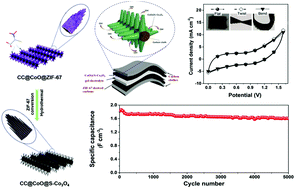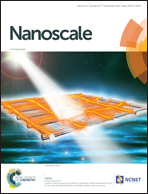Metal–organic framework-templated synthesis of sulfur-doped core–sheath nanoarrays and nanoporous carbon for flexible all-solid-state asymmetric supercapacitors†
Abstract
Metal–organic frameworks (MOFs) provide great opportunities for synthesizing advanced electrode materials with hierarchical hollow architectures for energy storage. Herein, we report the facile fabrication of core–sheath nanoarrays (NAs) on carbon cloth (CC@CoO@S-Co3O4) for binder-free electrode materials with MOFs as versatile scaffolds. The hollow S-doped Co3O4 sheath has been facilely prepared using a two-step synthetic protocol, which includes the surface etching of CoO nanowires for synchronous in situ growth of well-aligned ZIF-67 and its following hydrothermal process. The synergistic effect between CC nanofibers and hollow ordered NAs ensures efficient mass and electron transport. The pseudocapacitive NAs present a highest areal specific capacitance of 1013 mF cm−2 at 1 mA cm−2. By assembling the same MOF-derived nanoporous carbons and NAs as the corresponding binder-free anode and cathode, the flexible all-solid-state asymmetric supercapacitors deliver a highest energy density of 0.71 mW h cm−3 at 21.3 mW cm−3 power density, together with 87.9% capacitance retention over 5000 continuous cycles.



 Please wait while we load your content...
Please wait while we load your content...